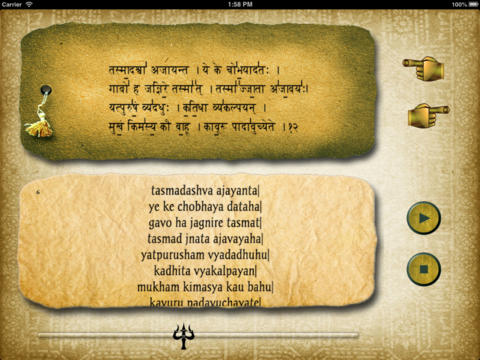
Purushasuktam
Purusha sukta is hymn 10.90 of the Rigveda, dedicated to the Purusha, the "Cosmic Being".
According to the ‘Srimad Bhagavatam’, the seer of this verse is Rishi Narayana and this ‘sukta’ is potent enough to rouse God-experience in the seeker.
The Purusha Sukta of the Vedas is not only a powerful hymn of the insight of the great Seer, Rishi Narayana (on the Cosmic Divine Being as envisaged through the multitudinous variety of creation) but also a shortcut provided to the seeker of Reality for entering into the state of Superconsciousness.
Significance:
The Sukta is charged with a five fold force potent enough to rouse God-experience in the seeker.
- Firstly, the Seer (Rishi) of the Sukta is Narayana, the greatest of sages ever known, who is rightly proclaimed in the Bhagavata as the only person whose mind cannot be disturbed by desire and, as the Mahabharata says, whose power not even all the gods can ever imagine. Such is the Rishi to whom the Sukta was revealed and who gave expression to it as the hymn on the Supreme Purusha.
- Secondly, the mantras of the Sukta are composed in a particular metre (chandas) which makes its own contribution by the generating of a special spiritual force during the recitation of the hymn.
- Thirdly, the intonation (svara) with which the mantras are recited adds to the production of the correct meaning intended to be conveyed through the mantras, and any error in the intonation may produce a different effect altogether.
- Fourthly, the Deity (devata) addressed in the hymn is not any externalised or projected form as a content in space and time, but is the Universal Being which transcends space and time and is the indivisible supra-essential essence of experience.
- Fifthly, the Sukta suggests, apart from the universalised concept of the Purusha, an inwardness of this experience, thus distinguishing it from perception of any object.
The Sukta begins with the affirmation that all the heads, all the eyes, and all the feet in creation are of the Purusha.
Who can Recite Purushasuktam and how ? :-
** " camakaṁ namakaṁ caiva pauruṣasūktaṁ tathaiva ca nityaṁ trayaṁ prayuñjāno brahmaloke mahīyate " **
Meaning -- He whoever recites Namakam and Chamakam along with Purusa Sooktam on a daily basis, will be honoured in Brahmaloka.
- To begin with , it is recommended to start learning Purushasuktam from a Guru, since, it is supposedly the traditional way of learning any Vedic Hymns or Stotras.
- Purushasuktam, unlike other Slokas or Mantras, has great significance, when its notations are recited in the appropriate pitch. The notation for marking the syllables for chanting is generally known as the swara notation, signifying the pitch variation applicable to the vowel in the syllable.
The following are the most common notations used:
1) Unmarked letters are - udaata (no change in the pitch)
2) If you see a horizontal line below a letter, you have to drop the pitch – anudaata
3) If you see a vertical line above a letter, you have to raise the pitch – swarita .
4) If you see a double vertical line above a letter, you to raise and the pitch and stretch it – deergha swarita .
5) In specific instances the swara of the previous letter is carried till the next occurring anudata or till the end of that pada or mantra - Prachaya
Flexi Features of Purushasuktam App :-
1) The Sanskrit hymns (with notation), on every page is individually scrollable, that would match with the audio from the page, for reference and practising.
2) For moving between pages quickly, use the Trisul pointer and drag.


